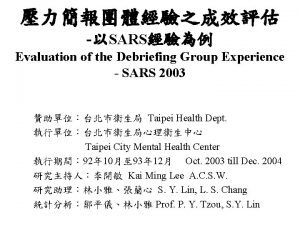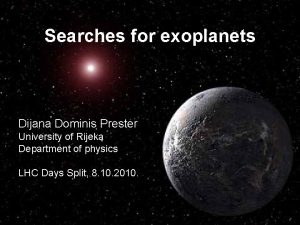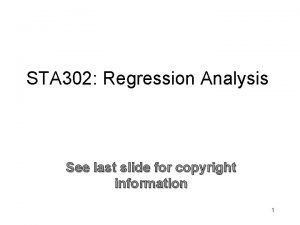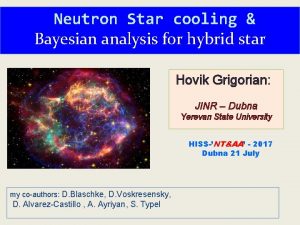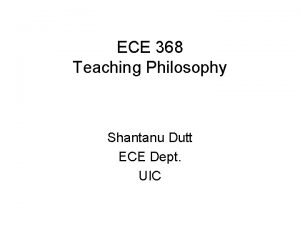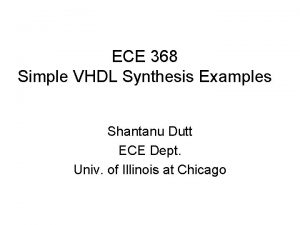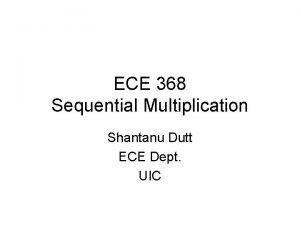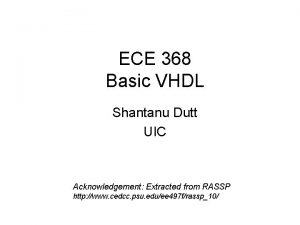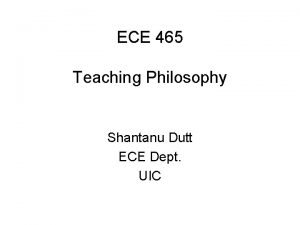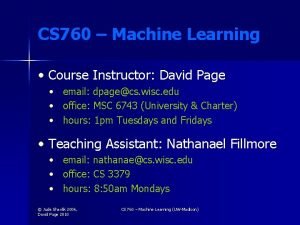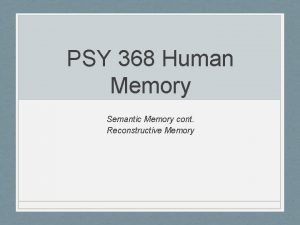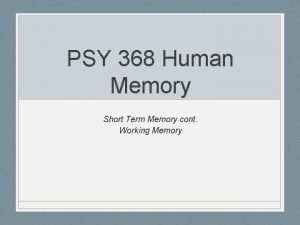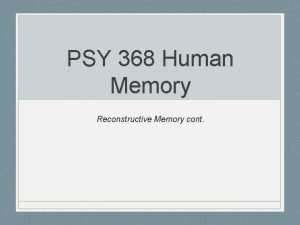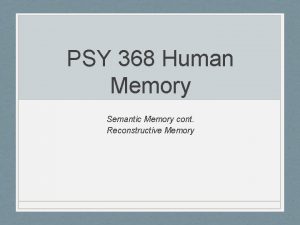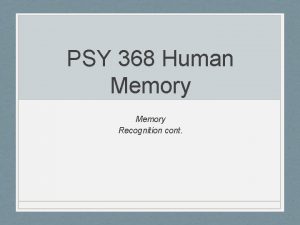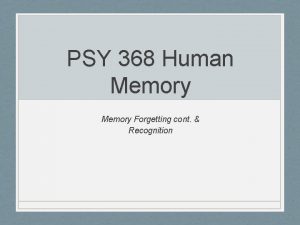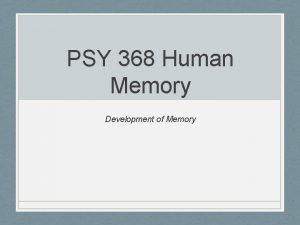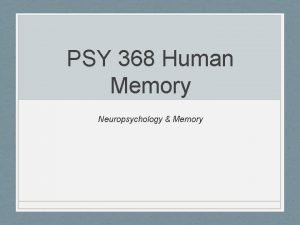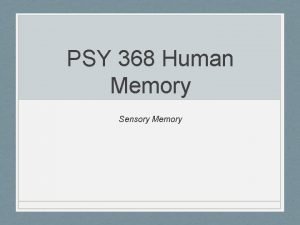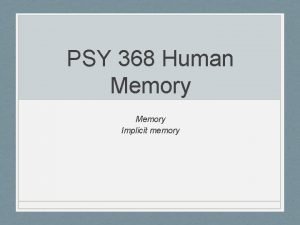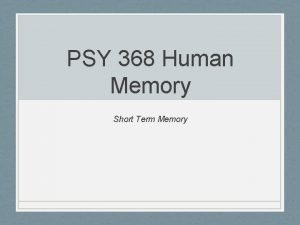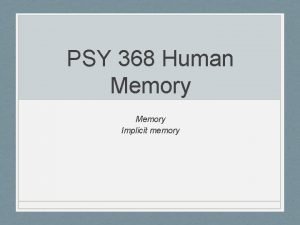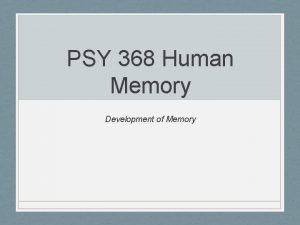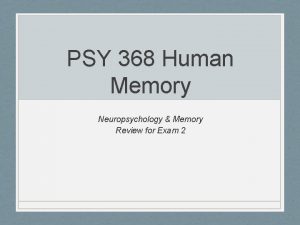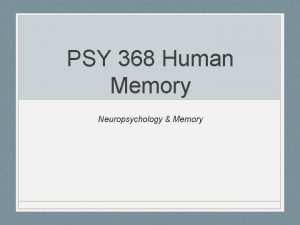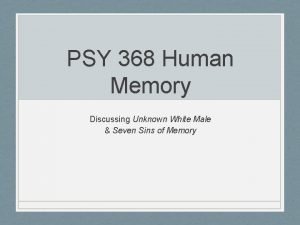PSY 368 Human Memory Working Memory cont Demos


















- Slides: 18

PSY 368 Human Memory Working Memory cont. Demos and reviews

Baddeley’s Model Visual scribe Articulatory Control

Phonological Loop • Two parts: Phonological Store (PS) and Articulatory Control Process (ACP) • PS - stores auditory info for 1 -2 s and then it starts to decay • ACP - recodes visual info into auditory code for storage and controls rehearsal • 4 Main Effects in Serial Recall Task to account for • • Phonological similarity effect Articulatory suppression effect Irrelevant speech effect Word length effect

Phonological Loop • Demos Listen to list, recall words in order Rhinoceros Zinc Gorilla Tuberculosis Measles Calcium Uranium Carbon Hippopotamus Mumps Listen to list, recall words in order, while I read the words say ‘the’ aloud Planet Musician Land Property Trumpet House Star Comet Orchestra Moon Bronze Book Magazine Bike Copper Dress Copier Soda Shoe Rock Listen to list, recall words in order, while I read the words say ‘the’ aloud Block Brick Stick Blue Chew Trick Prick Clue Click Blimp Read list, recall words in order, while I read the words say ‘the’ aloud Gold Code Bold Hold Told Cold Mode Slowed Hope Goad

Phonological Loop • Phonological Similarity Effect • Memory worse for items that sound alike than those that look alike or have similar meanings • Visual items are recoded to auditory for storage and rehearsal by ACP • Works for both auditory presentation and visual presentation of the letters. e. g. , Baddeley (1966) • List 1 (Easy to remember/dissimilar phonology and semantics): • PIT, DAY, COW, PEN, HOT • List 2 (Only slightly harder than List #1/similar semantics) : • HUGE, WIDE, BIG, LONG, TALL • List 3 (Much harder than List #1/similar phonology) : • CAT, MAP, MAN, CAP, MAD • What happens if you prevent the recoding of visual information into auditory information?

Phonological Loop • Articulatory Suppression Effect • Engaging in an auditory task after study removes phonological similarity effect for visual items • Procedure: Say “the” aloud over and over • No re-coding of visual info by ACP • Phonological info gets in directly, doesn’t need re-coding Auditory presentation: PGTCD (similar sounding) harder to recall than RHXKW (different sounding) Visual presentation: PGTCD (similar sounding) recalled equally as RHXKW (different sounding) No re-coding, so no chance for similar sounds to interfere With suppression

Phonological Loop • Irrelevant Speech Effect • Background speech presented during study decreases memory for visual items Salame & Baddeley (1982) 9 67 83 2 “nine six seven eight three two” ‘one’ ‘four’ ‘five’ Semantically similar ‘tun’ ‘sore’ ‘fate’ Phonologically similar ‘tennis’ ‘double’ Phonologically different Quiet control

Phonological Loop • Irrelevant Speech Effect • Background speech presented during study decreases memory for visual items Salame & Baddeley (1982) • Amount of disruption is determined by phonological similarity • In other experiments • showed no word-length effect for irrelevant speech • If rehearsal is prevented, irrelevant speech effect disappeared Conclusions: • Irrelevant speech interferes with recoding of visual info to auditory

Phonological Loop • Word-length Effect Baddeley, Thomson, and Buchanan (1975) Results • Recall decreases as the length of time it takes to say a word increases. • Rehearsal takes longer for longer words - can’t rehearse as many times • Retrieval from PS also takes longer due to auditory coding of items • Reading rate correlated with memory ability • Digit span depends on language - how long it takes to say numbers

Baddeley’s Model • Potential Problems with the model • Some of the supportive results can’t be replicated (e. g. , irrelevant speech effect) • Model can’t explain all results: • why word-length effect is larger for visual than auditory items • why it differs based on serial list position • Why some effects persist after extended delays (e. g. , 5 mins) • Model is not precise in explanation of effects

Cowan’s Activation Model • Cowan (1999) • WM = info that is currently highly activated from STM or LTM • Focus of attention • Emphasizes attention’s role in activation • Activation of info when attention is oriented to it • Activation will decay to cause loss of info from WM (also interference) WM STM

Cowan’s Activation Model • Central Executive • Focuses attention and other control processes • Capacity of about 4 chunks • Duration of 20 s without reactivation • STM • activated items that are just outside of attention passive store • Things within attentional focus are available to consciousness WM STM

Cowan’s Activation Model • Potential problems with the model • Only general descriptions so specific predictions are hard to make • Activation is not operationally defined very well when is something is “activated”? • What causes decay? Passage of time isn’t causal

Nairne’s Feature Model • Items represented in WM as individual features (e. g. , color, length, etc. ) • Features indicate • presentation info (e. g. , font, size, gender of voice, etc. ) • meaning info (e. g. , what the item means, category, etc. ) • Stays the same regardless of presentation • Features represented by -1 or +1 when studied (yes or no for a feature, 0 if no info for feature) • Interference: Later items with same features overwrite feature info for previous items

Nairne’s Feature Model Bold Lower Upper Blue SCHOOL +1 -1 fish +1 +1 +1 -1 -1 -1 • “fish” presented after “SCHOOL” - features in common can be overwritten - SCHOOL can become 0, -1, +1, 0 - interference During retrieval, item features are compared with items in memory - lost features can be updated and restored

Nairne’s Feature Model • Quantitative model - numerical predictions are possible - can simulate data to generate predictions for studies • Simulations show that model can predict: 1) Recency effect 2) Suffix effect 3) Phonological similarity effect 4) Word length effect

Summary of WM (1) Focus on processing (vs. storage) (2) Three main modern models - Baddeley model - - Cowan activation model - - Central executive controls VS, PL, EB WM = attention focus, STM = activated Nairne feature model (quatitative) - Items coded as features with overwriting interference

Exam 1 review Chapters 1 -4 Ebbinhaus and forgetting curve Seven Sins of Memory Review of research methods Modal systems theory(ies) of memory Sensory memory Iconic and echoic Partial report task Short term memory Chunking Serial and free recall Recency and primacy Working memory Baddeley’s model Phonological loop Episodic buffer Visuo-spatial buffer Cowan’s model Nairne’s model Duration, capacity, encoding, retrieval from the different memory systems Various Effects (suffix, modality, etc. ) Identify the “classic experiments & researchers”
